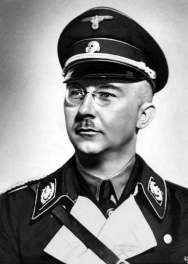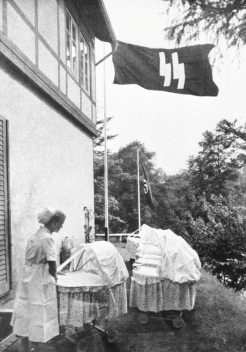We are delighted to welcome guest blogger and American MA graduate Katie Chaka, who wrote this post about Catholic women’s response to the Nazi Lebensborn programme.

‘Verein Lebensborn’ Taufe (1935), Bundersarchiv, Bild 146-1981-075-01
In Nazi Germany women’s primary function was widely considered to be reproduction. Their roles in German society during the rule of the National Socialist regime were increasingly limited and strictly defined by the traditional ideals of Küche, Kinder, and Kirche (kitchen, children, and church). Women were expected to embrace the value of their reproductive capabilities and focus primarily on being mothers and moralizers of the nation. One organization that fully capitalized on this gender stereotyping of women, as well as the encouragement of reproduction through eugenic measures, was the Lebensborn programme.

- ‘SS Photo’ (1937), Bundesarchiv, Bild 183-R99621
Lebensborn, meaning ‘Fount’ or ‘Well of Life’, was launched on 12 December 1935 by the Nazi SS organization under the direction of Heinrich Himmler. This programme aimed to provide “racially healthy” families with welfare aid in order to encourage them to produce larger numbers of children. It also gave maternity and childcare services to unwed mothers who could still provide a racially valuable child to the state outside the boundaries of traditional marriage. This secretive programme consisted of multiple maternity homes where women were able to bring their pregnancies to full term, free from the judgment of traditional societal norms. The Katholischer Deutscher Frauenbund (KDF), was the most liberal Catholic women’s organization with 200,000 members. It promoted women’s rights within the church and community, and thus particularly resented this type of intrusion by the state into family affairs. As a result, responses from the KDF display a distinct shift from adaptation to opposition in 1935, regarding issues related to motherhood and morality. This shift was largely due to the perceived negative social and religious effects of the Lebensborn program in German society.
As women and as Catholics, they met Hitler’s 1933 appointment as Chancellor with silence, as they awaited an official response from the Vatican in Rome. As Der Gerade Weg, a Catholic weekly journal explained, “The Church can wait. Her great strength lies in this waiting, in her ability to suffer..”. Due to the Concordat negotiations between the Vatican and Nazi leaders, women initially attempted to adapt to new Nazi ideas and policies, because Church leaders believed the regime would protect their religious autonomy. The KDF in particular fought to remain autonomous by rejecting mergers from not only Catholic male organizations, but from the NS-Frauenschaft as well. Unfortunately for German Catholics, almost immediately after Concordat negotiations were finished, the Nazi regime began stripping the Catholic community of its religious rights.

‘Schwester in einem Lebensbornheim’ (1942), Bundesarchiv, Bild 146-1973-010-11
Throughout 1934, Catholic institutions began to understand the extent to which Christianity and Nazism were incompatible ideologies. An article in the KDF journal Die Christliche Frau from 1934 argued that the state of modern marriage was a degeneration of its former self and warned against the “national license for sexual excesses”. The article critiqued society by asking its female readership if the Catholic Church even had authority over issues dealing with virginity anymore. Yet Catholic women were about to become increasingly more uncomfortable with the Nazis’ overt deviation from traditional religious norms of morality.
From 1935 onward, there is a perceptible shift that can be seen with regard to responses by the KDF towards issues of morality and motherhood in German society. Therefore, statements made by Catholic women, their organizations, and Church leaders that discuss the crumbling standards of morality should be read as a direct, but also veiled, response to the ideals for which Lebensborn stood, as well as the institution itself. There is no question that this was in response to the public propaganda blitz targeting the German youth on the basis of “biological marriages” instead of traditional marriages, launched that same year. A leading concern for the KDF was the subordination of “many adolescent girls operating in a downright sinister fashion”. It is also no coincidence that this was the year in which Lebensborn was founded. Therefore, the organization created a need for the eradication of Christian moral norms since traditional norms would harm Himmler’s overall goals. While it is unclear if women in the KDF knew the particularities of the Lebensborn program, they openly and consciously disapproved of, and openly responded to, the very foundation that the organization was built on.
KDF women consistently addressed these issues of morality in their writings, correspondence, and educational paths. Secular baptisms, educational classes favoring Germanic roots over religious teachings, and the validation of illegitimacy within Lebensborn homes caused many Catholic women to oppose the Nazi regime through their available outlets. The KDF specifically began to encourage women to educate their families on the sacraments of marriage and baptism within the privacy of their own homes. President Gerta Krabbel also wrote to Cardinal Michael von Faulhaber to inform him that her organization would be taking religious matters into its own hands, due to the lack of support from the male hierarchy of the Church.
As much as KDF women vociferously opposed the encouragement of the regime towards sexual “immorality” and bearing illegitimate children through the Lebensborn programme, they did not take nearly as strong a stance towards the treatment of the Jews and other minorities. Reoccurring themes throughout women’s documents present their willingness to stand up against political issues that they found incompatible with their religious beliefs, yet they did so on a selective basis. Nevertheless, the complicated, and sometimes heavily veiled, responses of Catholic women can greatly add to our understanding of women’s experiences during the Third Reich by giving new insights into how Nazi eugenic policies could conflict with Christian faiths.
Katie Chaka is an M.A. graduate from Oakland University, Michigan USA.
We would like to thank Katie for her post and encourage other students working on women’s and gender history, in the UK and at overseas HE institutions, to submit posts for consideration. We are always happy to receive them.
